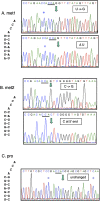Two forms of RNA editing are required for tRNA maturation in Physarum mitochondria
- PMID: 20106952
- PMCID: PMC2822913
- DOI: 10.1261/rna.1958810
Two forms of RNA editing are required for tRNA maturation in Physarum mitochondria
Abstract
The mitochondrial genome of Physarum polycephalum encodes five tRNAs, four of which are edited by nucleotide insertion. Two of these tRNAs, tRNA(met1) and tRNA(met2), contain predicted mismatches at the beginning (proximal end) of the acceptor stem. In addition, the putative 5' end of tRNA(met2) overlaps the 3' end of a small, abundant, noncoding RNA, which we term ppoRNA. These anomalies led us to hypothesize that these two Physarum mitochondrial tRNAs undergo additional editing events. Here, we show that tRNA(met1) and tRNA(met2) each has a nonencoded G at its 5' end. In contrast to the other nucleotides that are added to Physarum mitochondrial RNAs, these extra G residues are likely added post-transcriptionally based on (1) the absence of added G in precursor transcripts containing inserted C and AA residues, (2) the presence of potential intermediates characteristic of 5' replacement editing, and (3) preferential incorporation of GTP into tRNA molecules under conditions that do not support transcription. This is the first report of both post-transcriptional nucleotide insertions and the addition of single Gs in P. polycephalum mitochondrial transcripts. We postulate that tRNA(met1) and tRNA(met2) are acted upon by an activity similar to that present in the mitochondria of certain other amoebozoons and chytrid fungi, suggesting that enzymes that repair the 5' end of tRNAs may be widespread.
Figures




Similar articles
-
Unexpectedly complex editing patterns at dinucleotide insertion sites in Physarum mitochondria.Mol Cell Biol. 2004 Sep;24(18):7821-8. doi: 10.1128/MCB.24.18.7821-7828.2004. Mol Cell Biol. 2004. PMID: 15340046 Free PMC article.
-
Insertional editing of mitochondrial tRNAs of Physarum polycephalum and Didymium nigripes.Mol Cell Biol. 1998 Dec;18(12):7521-7. doi: 10.1128/MCB.18.12.7521. Mol Cell Biol. 1998. PMID: 9819437 Free PMC article.
-
Insertional editing in isolated Physarum mitochondria is linked to RNA synthesis.RNA. 1997 Aug;3(8):821-37. RNA. 1997. PMID: 9257642 Free PMC article.
-
Insertional editing in mitochondria of Physarum.Semin Cell Biol. 1993 Aug;4(4):261-6. doi: 10.1006/scel.1993.1031. Semin Cell Biol. 1993. PMID: 7694673 Review.
-
[RNA editing in different genetic systems].Zh Obshch Biol. 2004 Jan-Feb;65(1):52-73. Zh Obshch Biol. 2004. PMID: 15032065 Review. Russian.
Cited by
-
tRNA 5'-end repair activities of tRNAHis guanylyltransferase (Thg1)-like proteins from Bacteria and Archaea.Nucleic Acids Res. 2011 Mar;39(5):1833-42. doi: 10.1093/nar/gkq976. Epub 2010 Nov 3. Nucleic Acids Res. 2011. PMID: 21051361 Free PMC article.
-
A role for tRNA(His) guanylyltransferase (Thg1)-like proteins from Dictyostelium discoideum in mitochondrial 5'-tRNA editing.RNA. 2011 Apr;17(4):613-23. doi: 10.1261/rna.2517111. Epub 2011 Feb 9. RNA. 2011. PMID: 21307182 Free PMC article.
-
Electroporation of DNA into Physarum polycephalum Mitochondria: Effects on Transcription and RNA Editing in Isolated Organelles.Genes (Basel). 2016 Dec 14;7(12):128. doi: 10.3390/genes7120128. Genes (Basel). 2016. PMID: 27983641 Free PMC article.
-
Arm-less mitochondrial tRNAs conserved for over 30 millions of years in spiders.BMC Genomics. 2019 Aug 23;20(1):665. doi: 10.1186/s12864-019-6026-1. BMC Genomics. 2019. PMID: 31438844 Free PMC article.
-
A mitochondrial cytidine deaminase is responsible for C to U editing of tRNATrp to decode the UGA codon in Trypanosoma brucei.RNA Biol. 2021 Oct 15;18(sup1):278-286. doi: 10.1080/15476286.2021.1940445. Epub 2021 Jul 5. RNA Biol. 2021. PMID: 34224320 Free PMC article.
References
-
- Binder S, Marchfelder A, Brennicke A. RNA editing of tRNAPhe and tRNACys in mitochondria of Oenothera berteriana is initiated in precursor molecules. Mol Gen Genet. 1994;244:67–74. - PubMed
-
- Bullerwell CE, Gray MW. In vitro characterization of a tRNA editing activity in the mitochondria of Spizellomyces punctatus, a chytridiomycete fungus. J Biol Chem. 2005;280:2463–2470. - PubMed
Publication types
MeSH terms
Substances
Grants and funding
LinkOut - more resources
Full Text Sources
